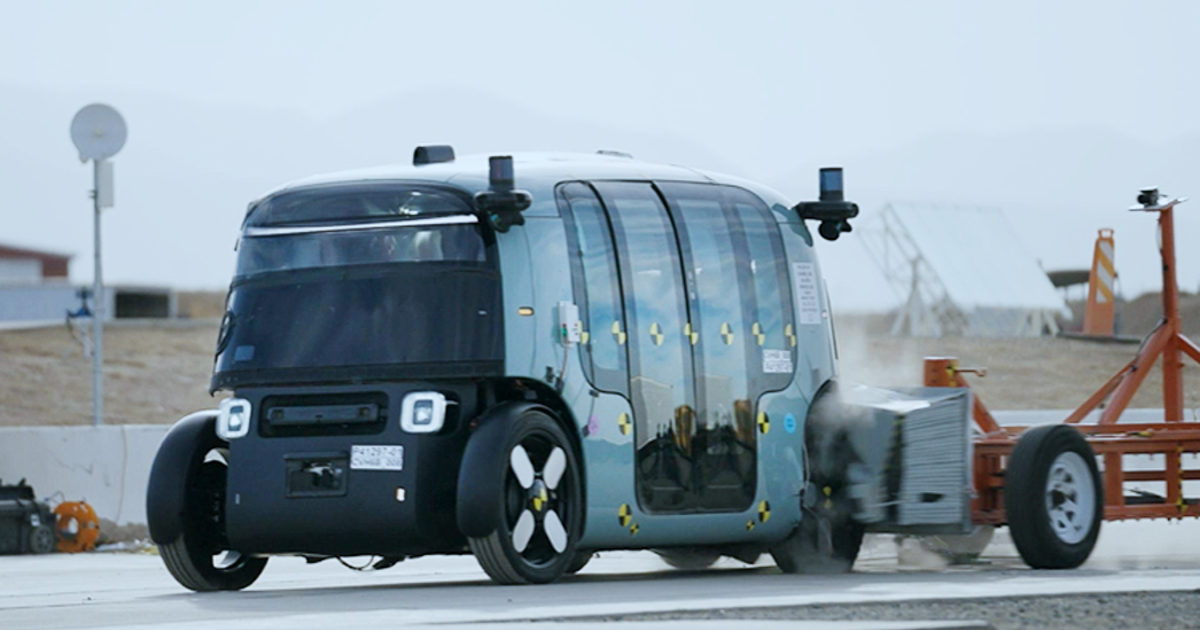
Self-driving tech company Zoox Inc. may have created a robotaxi that looks like nothing else on the road today. But the Amazon-owned company says the process it used to ensure its toaster-shaped vehicles met federal safety standards is a conventional one used by other manufacturers.
“People look at it and go, ‘How is this possible?’ and ‘How can you do this?’ ” Amanda Prescott, director of homologation at Zoox, told Automotive News. “They don’t understand the certification process. We’ve done the same thing as everybody else.”
Zoox disclosed more information Wednesday about its self-certification and occupant-protection efforts in the wake of fresh scrutiny from federal regulators.
The company released a video compilation that showed its crash-testing efforts and described the battery of tests it used to determine its purpose-built electric robotaxi met or exceeded the crash-test performance requirements of the Federal Motor Vehicle Safety Standards.
Those crash tests occurred a year ago. Those crash tests are the foundation of Zoox’s self-certification efforts.
NHTSA officials started scrutinizing Zoox’s self-certification last month, days after Zoox first began using its vehicle on public roads. The agency opened an audit query to examine that process and collect technical data.
The query remained ongoing Wednesday, according to NHTSA’s records.
Regulators neither preapprove nor prohibit the introduction of new vehicles or vehicle technology in the U.S. Manufacturers may self-certify they conform with existing safety standards, and NHTSA conducts an occasional audit query to assure compliance.
But it gets tricky with autonomous vehicles. The Zoox vehicle lacks traditional vehicle controls like a steering wheel or brake pedals, and it contains a carriage-style seating arrangement not addressed in the federal regulations.
Regulators have carved out a special regulatory path for self-driving vehicles. Autonomous vehicle companies can request an exemption from federal safety standards if they can show such unconventional vehicular designs meet or exceed existing levels of safety.
But the exemption process has proven cumbersome. Both Ford and General Motors, for example, ultimately withdrew requests that went unanswered for more than a year. A separate GM exemption request made in February 2022 still lingers.
Zoox stands as the first and only autonomous vehicle company to utilize the more straightforward self-certification process as conventional manufacturers. Should that pass federal muster, it’d be a bellwether moment for the autonomous vehicle industry and provide a potential pathway for others to follow.
Certification is a moment Zoox has anticipated for a long time. Since its founding in 2014, its engineers have crafted its bidirectional electric vehicle with both innovation and the federal motor vehicle safety standards in mind, particularly those that address occupant protection and crash mitigation.
Zoox said Wednesday it conducted at least six crash tests that included a frontal crash, offset, angled and side-moving barrier test that addressed sections 208 and 214 of the federal requirements. Further, it conducted a high-speed rear impact test outlined in section 305 that sets standards for high-voltage powertrains.
Zoox utilized a third-party facility for the tests but declined to say where they were conducted. The vehicle met or exceeded applicable performance requirements, according to Christopher Nalevanko, general counsel at Zoox.
Testing permitted Zoox to vet its unique horseshoe-shaped airbag design. With no dashboard to serve as a springboard, Zoox engineers airbags that surround the passenger cabin, similar to conventional side-curtain airbags.
But they simultaneously deploy in a way that addresses frontal crashes and maintains separation between occupants and mitigates certain types of injuries. The two-in-one design is unprecedented in the industry, said Prescott, who worked as a compliance engineer at NHTSA between 2002 and 2006.
“That’s one of the really cool innovations that we’ve done to enable our carriage seating design and provide an equivalent level of safety for everybody in the car,” she said.
Equivalent safety for all occupants itself is a safety innovation, she argued. Federal requirements set more stringent standards for protecting front-row occupants. But in the Zoox vehicle, “everybody gets the same stuff,” Prescott said.
Another aspect of the vehicle designed with crash-test standards in mind include the crumple zones, which dissipate crash energy before it reaches the passenger cabin. Little space existed for crumple zones on a bidirectional vehicle designed with tight turns in mind.
Zoox expended further efforts to ensure its doors stay closed in the event of a crash to prevent ejections and coupled that with the ability for remote customer-assistance operators to communicate with passengers and unlock doors in the event of an emergency.
Overall, the safety innovations and design are “driving toward all the good things that come beyond [Federal Motor Vehicle Safety Standards],” Prescott said. “The way I like to think of it is the [federal safety standards] gives us the foundation on which to build.”